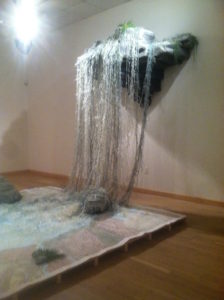Rice is Life and Simulacratopia (again) Use Art to Address Social Issues
When visitors enter the Rice is Life exhibit they are greeted with bowls hanging from red string casting a grid of shadows on the ground. The bowls are made entirely from biodegradable materials. Statistics are posted on the wall detailing the problem of hunger in the world, Connecticut and then specifically Bridgeport.
The Housatonic Art Museum has been home to been many exhibits over the years however, it recently showcased two unique installations that focus on bringing awareness to social issues. The installations Rice is Life by Mary Giehl and Simulacratopia (again) both seek to shine a light on issues related to our relationship with the world. Kim Waale created Simulacraptopia(again) to make a statement on pollution while Mary Giehl is seeking to bring awareness to world hunger.
Mary Giehl is a former registered nurse who went back to school in 1985 and in 1989 and got a BFA from Syracuse University in Fiber Art. She says of the installation on her website “Hunger is not just about distant lands and peoples. This installation drives home the realization that hunger exists, even thrives, around us.”
Every piece of the exhibit was chosen purposefully to convey this message. In Giehl’s description of the installation she explains some of these choices and their meaning “To hang the individual bowls, Giehl imbedded red threads like a vascular system into her rice bowls, underscoring the very concept that brings life and rice together.
Suspending each bowl speaks to the fragility of nutrition and health in those places that rely upon rice as the primary food source, a fragility that resonates even more strongly in the thinness of the vessels themselves.”
On March 18 from 12:30 pm to 5:30 pm the Bridgeport Rescue Mission gave away the bowls used in the installation in exchange for donations of canned food.
On the other side of the museum sits Kim Waale’s installation Simulacratopia (again). The installation uses unnatural objects to stress the importance of our relationship with the world. Waale, a professor of art at Cazenovia College, describes the piece as “whimsical fiction, a slippage between reality and artifice, made of dumb materials and yet, it’s a plastic sublime—a romantic natural hybrid.”
Plastic hangs down, creating a waterfall and a contrast between the materials used and the natural world that it recreates.Waale said of the installation it “is really the perfect venue for raising questions about simulacra –superficial likenesses, insubstantial copies, and stand-ins for the real thing.”
This highlights both difference and distance from the “real” thing represented. Most of us prefer to experience the natural world in an entertaining, profitable, comfortable, controlled manner and from safe distance.
Simulacrutopia (again) asks: is a 100% artificial version of the natural world acceptable?
The museum placed benches on either side of the installation offering visitors an opportunity to sit and enjoy the piece much like they might enjoy nature, a choice that Gallery Director, Robbin Zella, says was intentional. She wanted them “to look like park benches. It’s tongue and cheek because nothing in the exhibit is real.”
While the two exhibits are very differently constructed as far as materials, Rice is Life is made entirely of biodegradable materials while nothing in Simulacrutopia(again) is natural, both artists hope to make students think of their relationship to the world.
Waale said of her installation “I hope to trigger in viewers a heightened an awareness of this position and to raise questions about our current trajectory. How sustainable is this relationship to the natural world?”
While Mary Giehl said she hopes that her “art is remembered…maybe students will think about the issue more.”
HCC student Arielle Hincapie certainly did.
“I never really thought how serious hunger is in some parts of the world until seeing this. It makes me more grateful for the resources I have,” Hincapie said.

